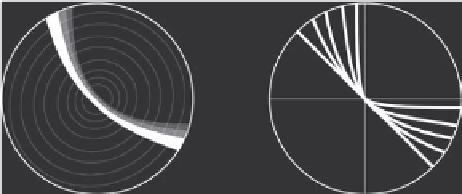Chemistry Reference
In-Depth Information
2.6.3 Biaxial mineral: section perpendicular
to an optic axis
The isogyre is a branch of hyperbola passing through the center of the field.
If the stage is rotated, the hyperbola rotates in the opposite direction,
being reduced by 4 times each turn to a straight line parallel to the cross
hairs of the reticle.
The isochromes are curves, close to ovals of Descartes (actually very
close to circles).
The curvature of the hyperbola is a function of 2V: very strong for small
2V, close to the curvature of the field for 2V
=
45°, nearly straight for 2V
close to 90°.
2.6.3.1 Determining optic sign
By adding an accessory plate (quartz in the case of Figure 2.14) sensitive,
with the concavity of the hyperbola is in the NE quadrant:
if the mineral is positive biaxial, the NE quadrant take blue colors
(higher in the Michel-Lévy chart), SW quadrant takes red-orange, yel-
low, etc. colors;
if the mineral is negative biaxial, the reverse occurs.
2V
15° 0°
45°
90°
Figure 2.13
Convergent light interference figure of a biaxial mineral cut perpendicular to
the optic axis.
γ
accessory
plate
Blue
Red
Blue
Red
section perpendicular to an optic axis: positive biaxial B+
Figure 2.14
Optic sign of a biaxial mineral cut perpendicular to an optic axis.































